Anneke Ball on Harry and Meghan’s Trip: ¿Por Qué Colombia?
‘As Colombians like to say: If you were to visit, the only risk is wanting to stay.’
Hello! I am closing out coverage of the Sussexes in Colombia today with a guest essay by Anneke Ball. Born in Venezuela, Anneke is a longtime royal follower and an award-winning journalist who has worked at ABC News as well as Business Insider, Telemundo and Univision.
I asked Anneke to follow Harry and Meghan’s trip and keep tabs on coverage in the local media. She also reached out to people in Colombia, including a business owner in Bogotá and a resident of San Basilio de Palenque village, for their thoughts on the visit. Below, Anneke reflects on what this trip meant to the couple, the vice president who extended the invitation, and the country itself, which is in the midst of a global rebrand of sorts.
Thank you for your support of So Many Thoughts, which makes it possible for me to do this work and pay contributors! If you haven’t already, please consider upgrading for $5 / month. A paid subscription includes access to the SMT archive, where you will find all of my fashion commentary — the Colombia collection is here.
Anneke Ball on Harry and Meghan’s Trip: ¿Por qué Colombia?
This newsletter may get cut off in your inbox — click here to read it in your browser (or desktop, where it looks best!)
By Anneke Ball
As someone who has been a self-proclaimed “royal correspondent” for years, I was eagerly waiting for the Sussexes to touch down in Colombia, a place close to my heart, where I married my cachaco husband — as those from Bogotá are known — in 2023.
The royals are no strangers to the South American country. Then-Prince Charles and Camilla visited in 2014, and the Duchess of Edinburgh last year, both trips aimed at strengthening diplomatic ties and supporting global initiatives. But as Prince Harry and Meghan no longer represent the interests of the British government, and their trips are done in a private capacity, it led many — including myself — to wonder: ¿Por qué Colombia? What’s in it for the Sussexes and for Vice President Francia Márquez, who extended the invitation? And what’s in it for Colombia, a once notorious country that has for over a decade enjoyed a transformed tranquility that lures travelers from all over the world?
For the Duke and Duchess of Sussex, the visit seemed to be aligned with causes supported by the couple’s Archewell Foundation. Harry and Meghan participated in a forum in the capital of Bogotá advocating for mental health and combating cyberbullying, met with military members and veterans, visited San Basilio de Palenque — the first free African town in the Americas — and spoke about the challenges facing women of African descent.
They were joined each day by Ms. Márquez, a former environmental and human rights activist. She is the country’s first woman of African heritage to be vice president; in 2023, she also became the nation’s first Minister of Equality and Equity, promising to work for the most vulnerable.
In a press conference ahead of the visit, Ms. Márquez revealed she reached out to Sussexes after watching their Netflix documentary and being deeply moved by their story.
Ms. Márquez grew up in a small town and had a daughter when she was 16, whom she raised on her own cleaning homes in the nearby city of Cali, according to Associated Press. She went on to become an environmental leader and in 2018 was awarded the 2018 Goldman Environmental Prize for her efforts to remove gold miners from her village.
Since taking over the newly formed Ministry of Equality and Equity, her department has been mired in controversy, frequently criticized as a bureaucratic entity. El Tiempo reported that most of the ministry’s spending was allocated to salaries, and little to programs and activities. Ms. Márquez has defended her post saying she is building an institution from scratch. The vice president has also been criticized for her frequent use of helicopters to commute, flying to her home in Dapa, an area in Western Colombia known for its country homes. In an interview with Semana, she attributed these criticisms to discrimination. A poll conducted in July by Invamer shows Márquez’s approval rating is around 27%, while almost 60% of Colombians disapprove of her work.
During the Sussexes’s visit, Ms. Márquez — whom Meghan referred to as “amiga” in a speech in Spanish — highlighted how happy she was that the Duke and Duchess said yes to visiting Colombia, in spite of an often negative global perception.
It’s a sentiment shared by Ramón Viveros Ortiz, a lawyer and business owner of Bantura Viche, a company that sells viche, a liquor traditionally produced by the Afro-Colombian community. “[The visit] can allow the world to have a vision of Colombia that is freer from stereotypes about the country,” he said in an interview, “so that more people can get to know Colombia as a destination of peace, biodiversity, and investment.”
Still, Viveros Ortiz worries the Sussexes’s trip may be boiled down to mere media hype if it doesn’t lead to tangible outcomes. “Being in the spotlight always generates expectations, but we need concrete actions,” he said. “Therefore, until there is an official statement regarding agreements and plans, the only thing this represents for the Afro-Colombian people is another illusion of achieving economic and social justice to stop being merely a cultural attraction.”
For Tomasa Herrera, from the San Basilio de Palenque village visited by the Sussexes, the visit could prove to be beneficial to her community: “It can help create platforms to share stories and experiences about Afro-Colombians.”
The Duke and Duchess’s visit may shine a light on the wonders Colombia has to offer. Despite experiencing a transformation, the South American country has long struggled to leave behind its reputation for drugs and kidnappings, with even British tabloids describing it as a “crime-ridden country” ahead of the visit. While armed groups remain active in parts of the country, there has been a dramatic reduction in violence after the government fought guerrillas and cartels in the early 2000s and a peace treaty was signed in 2016.
As Colombians like to say: If you were to visit, the only risk is wanting to stay. The Latin American country is truly the land of “magical realism” — a term coined by Colombian Nobel Prize-winning author Gabriel García Márquez to describe its vibrant culture that seems right out of a fairytale. I love strolling through Cartagena’s old town; the cobbled streets make you feel as if you've stepped back in time. (If you watched Encanto, you get the vibe.)
In a nod to local fashion, the duchess was seen wearing a number of pieces by Colombian designers, including a patterned pink dress by Johanna Ortiz, a sequined skirt by Silvia Tcherassi, and a dress by Andrés Otalora ironically named “Joya Colonial” or “Colonial jewel.” My favorite item was not by a Colombian brand, but an heirloom from Meghan’s late mother-in-law, Princess Diana. The butterfly earrings the duchess wore to visit a school in Santa Fe were seen on Princess Diana in Canada in 1986. Colombia has the highest number of butterfly species in the world; they have become one of the most representative symbols of García Márquez’s literary universe.
“As Colombians like to say, if you were to visit, the only risk is wanting to stay.”
Throughout the trip, I wondered if we would see Meghan spotlight lesser-known brands, not just high-end Colombian designers—perhaps even a mochila purse made by artisans from the Wayuu Indigenous tribes. I was disappointed we didn’t see Harry donning a Guayabera, a linen shirt men often use in Latin America.
But I found Meghan’s outfits to be suitable for each location. In coastal Cartagena, she wore tropical and breezy outfits. In Cali, the land of salsa, she wore joyful outfits. While in Bogota, a chilly and often rainy city, Meghan donned a suede jacket and a navy Veronica Beard suit, which Colombian outlet El Pais was quick to point out was “worth millions” of Colombian pesos. This is to be expected on a trip where every detail is scrutinized. While the duchess looked elegant and chic, a Cartier necklace retailing for $13,400, and a $4,700 Loro Piana bag were bound to be eyeballed.
Others wondered how much the four-day trip could be costing Colombian taxpayers. For the couple’s visit on Saturday to Cartagena, 3,000 police officers were deployed, and 250 specifically assigned to safeguard the Sussexes and Vice President Márquez. Photos showed security vehicles, snipers, and even helicopters surrounding the area. These stringent measures were requested by Ms. Márquez, according to the city’s mayor’s office. (The vice president has been a target in the past. In January 2023, explosives were found next to a road near her home, which she described as an assassination attempt.)
Luis Ernesto Gómez, a political and economic analyst in Colombia, notes that while high-profile figures often get extra security, it could be seen as pulling resources away from other important matters. “Allocating security personnel to protect nobles while citizens are facing security challenges is certainly subject to justified criticism,” he said. There has also been criticism as to “why the vice president is dedicating time to this…when the populations she is supposed to represent are in a fairly critical situation.”
Still, he thinks it is beneficial that the Sussexes and the vice president held important discussions around race and discrimination, while also bringing Colombia into the international spotlight.
“As a Latina, I found it heartwarming to see the Sussexes immerse themselves in our culture.”
I don’t blame the Sussexes for wanting to visit Colombia. Its warm, welcoming culture is contagious. A taste of pandebono and Colombian coffee hurts nobody. Meghan herself said — in an impressive speech in Spanish — she could “feel Colombia’s embrace.” As a Latina, I found it heartwarming to see the Sussexes immerse themselves in our culture, joining drum classes and hitting the dance floor to salsa. I also hoped to see Meghan and Harry interact with local residents beyond those officially invited or involved in the events. With a heavy security presence around them, many were left only to catch a glimpse from the sidelines.
I’m still uncertain whether their visit can be considered a success. Will the Sussexes’s stardom bring significant change to some of the issues they discussed, perhaps even boost tourism? Or will it merely be remembered as part of Ms. Márquez’s own agenda and add to the expenses of an already unpopular government?
My thanks to Anneke! You can follow her on Instagram at @Anneke.Ball.
ICYMI: Catch up on all of my fashion commentary in the So Many Thoughts (SMT for short) archive. 💭 Click here for my Colombia coverage.






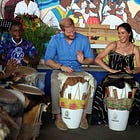

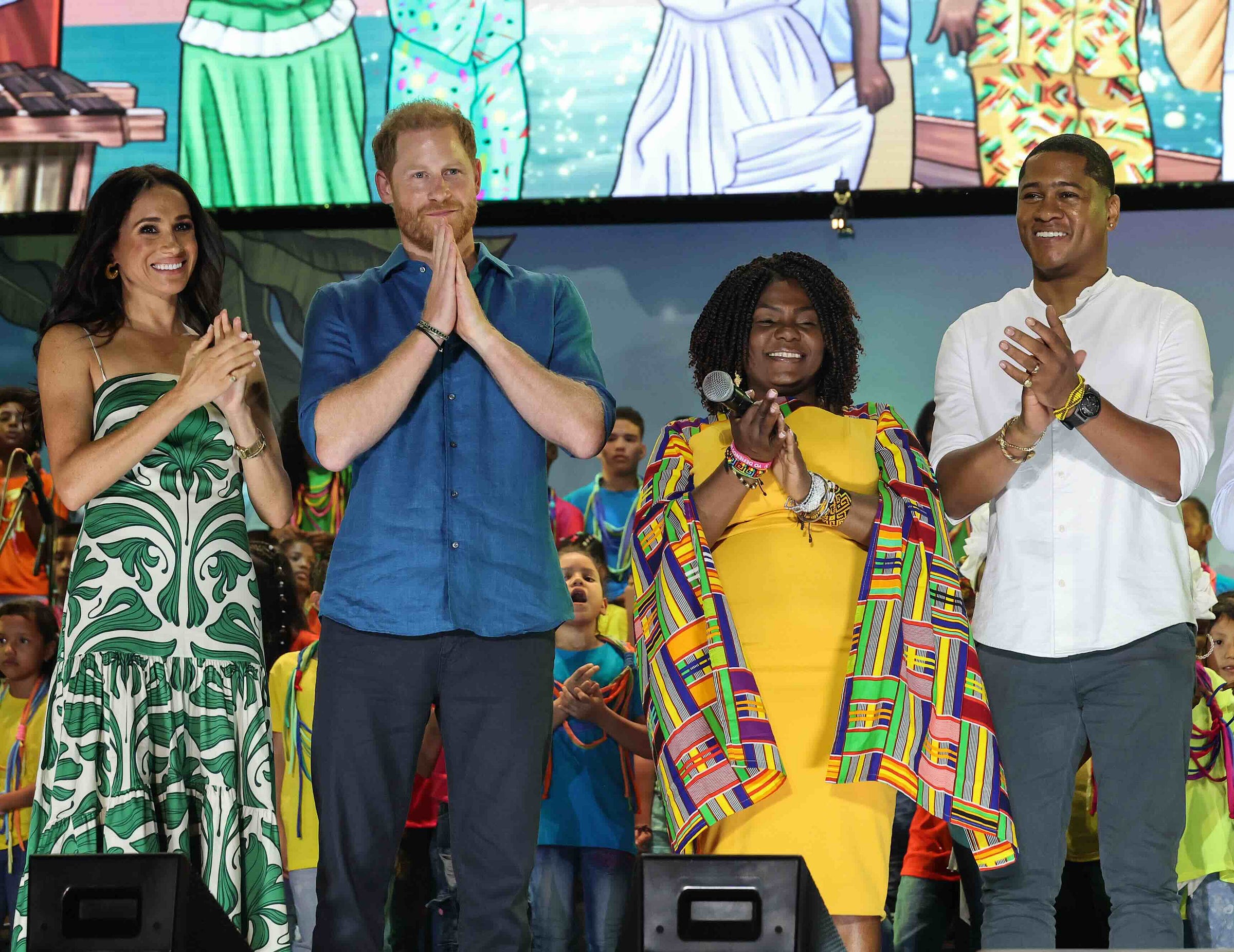

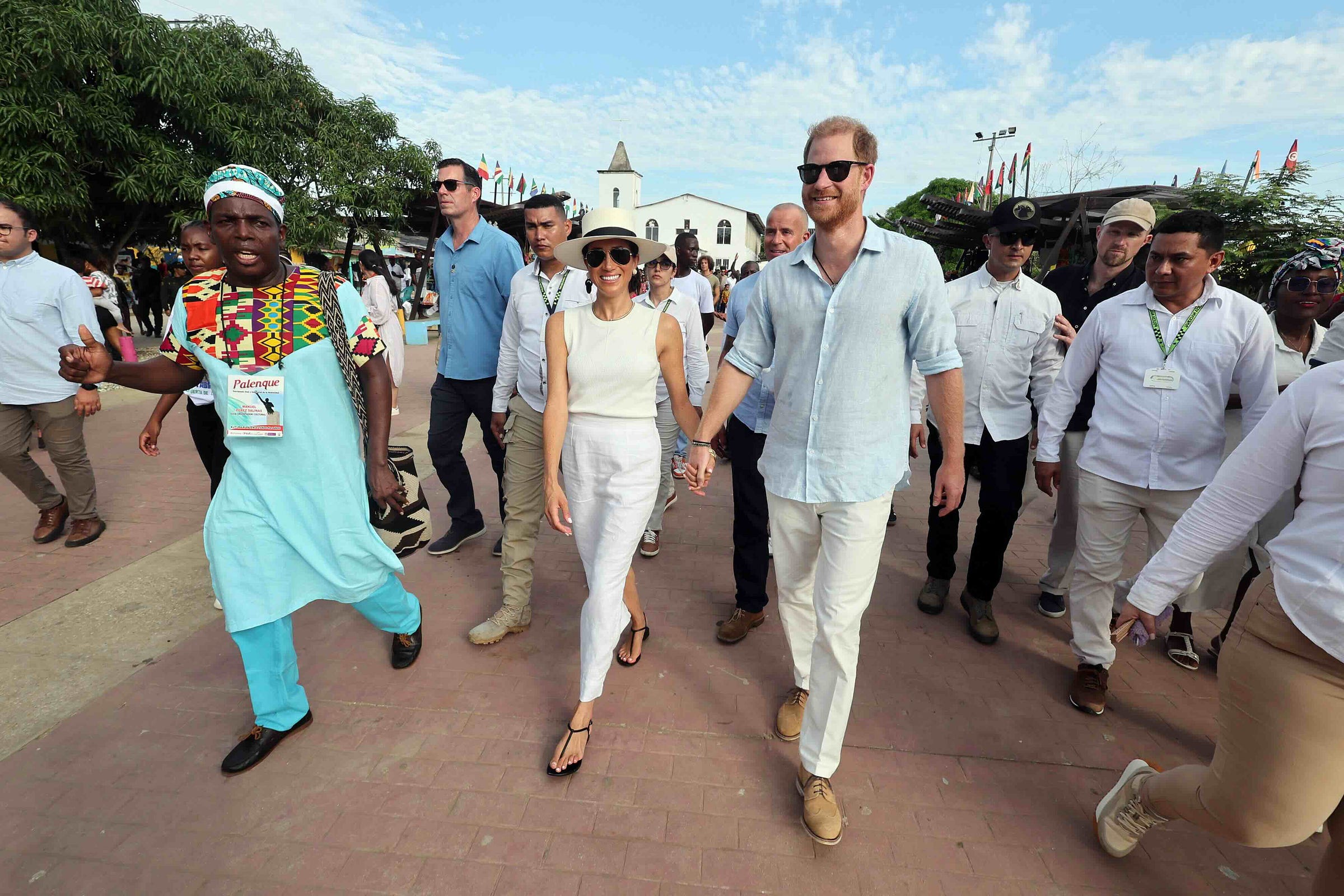
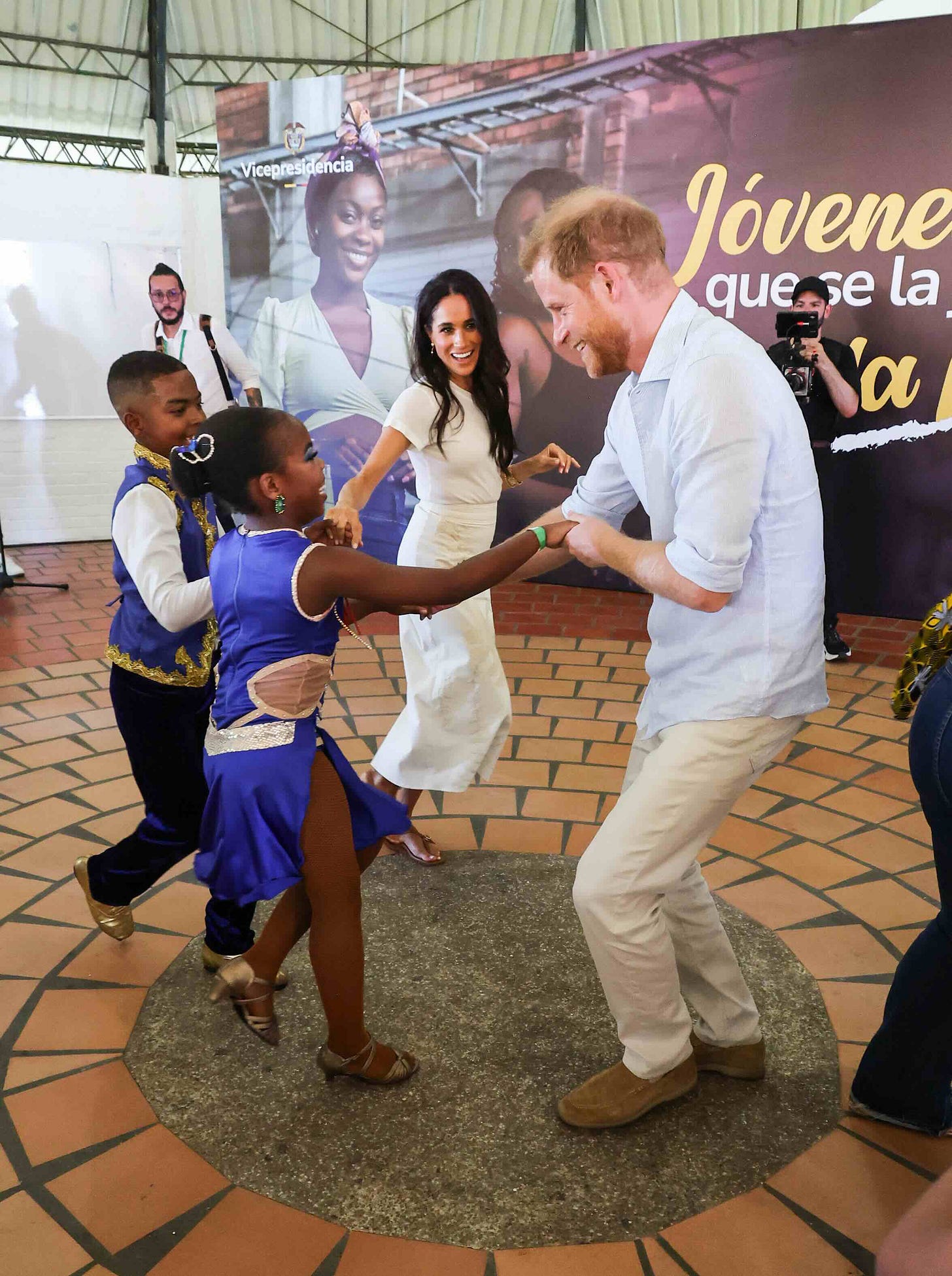

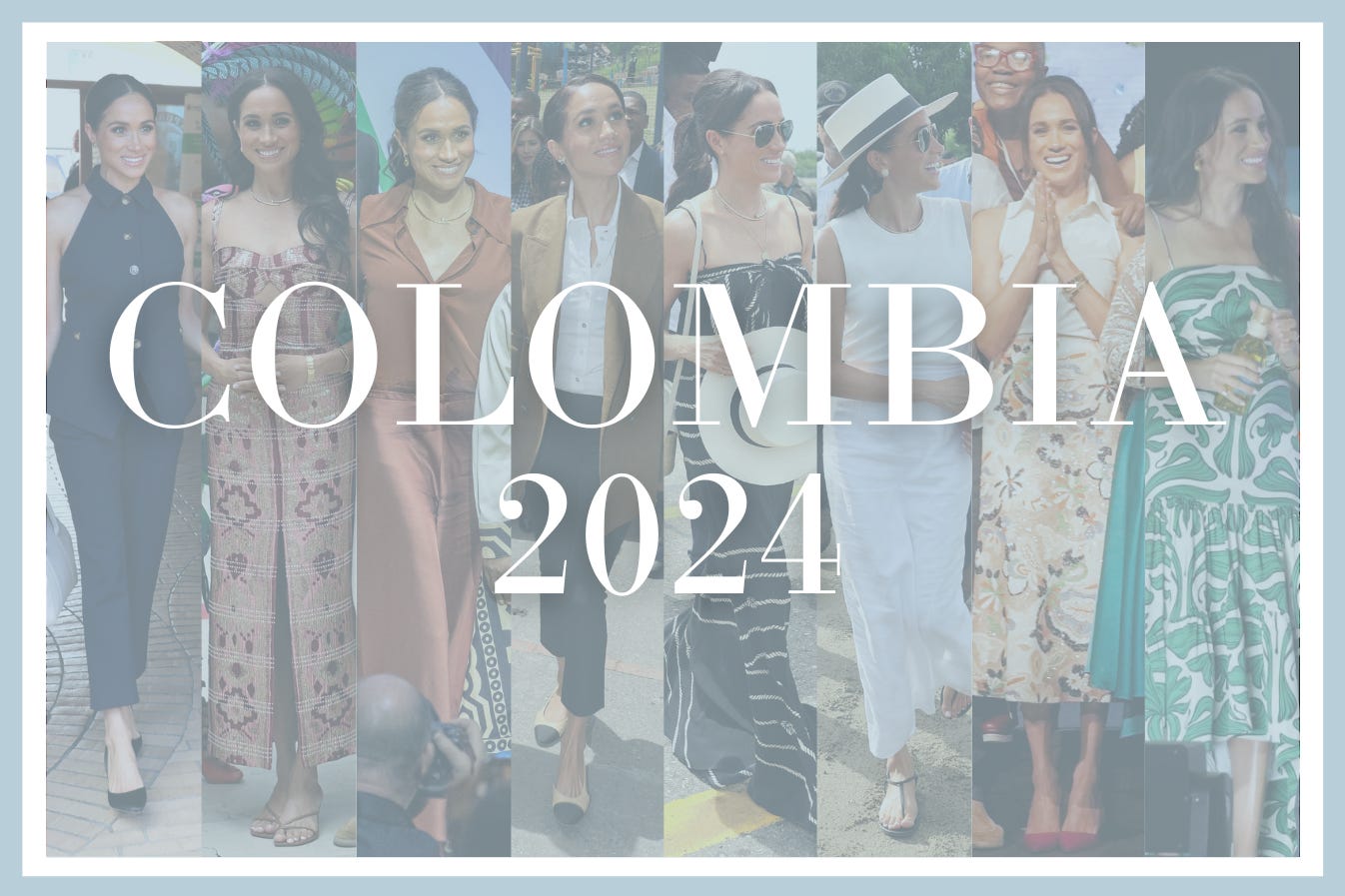
I always love these essays from people on the ground. So fascinating to hear people’s takes on their visit.
Thank you for this discussion of the trip and its value. I learned a lot about the country, its history, culture and people. I am quite glad that they went, and it appeared that each place they chose to visit highlighted another aspect of the country. Thanks, Elizabeth!